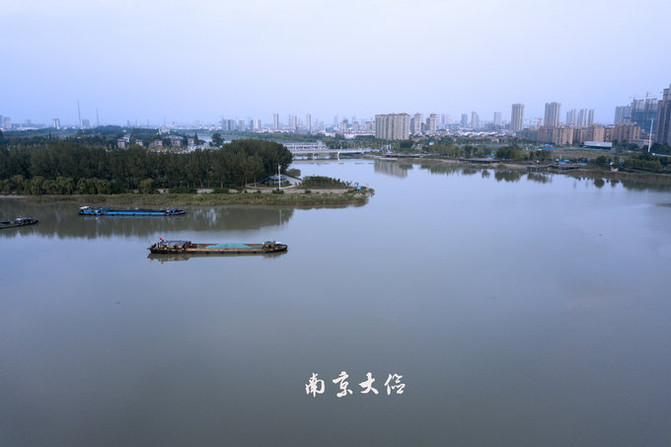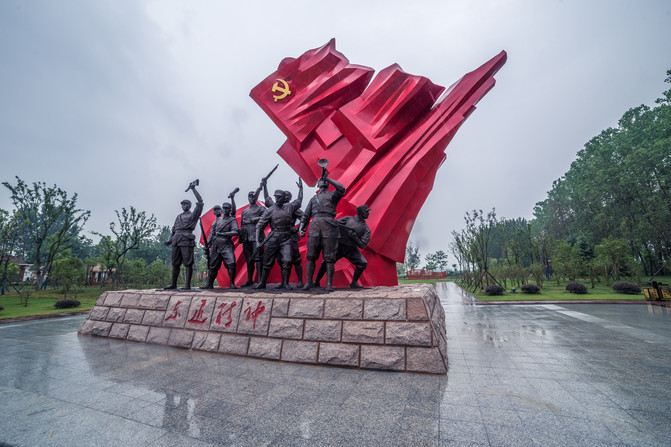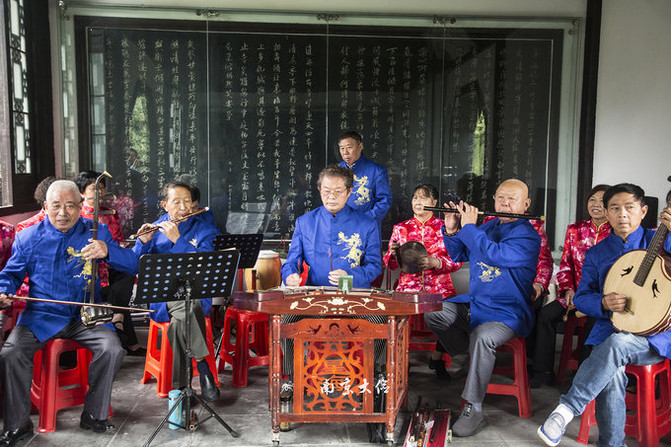Roaming Jiangdu and seeing the scenery woven by roads and water networks
Published on 2020-09-23 12: 161st Floor
In the golden autumn of September, the golden breeze sent me off, and I started a self-driving journey in Jiangdu with three or five friends.

Jiangdu, known as Longchuan in ancient times, was named after "the waters of Jianghuai gather here." It was established here during the Western Han Dynasty and was one of the earliest counties and counties on the Jianghuai Plain. This land is connected by rivers and lakes, and is moistened by the thousand-year-old Grand Canal and the surging Yangtze River eastward. This lush land is picturesque and has beautiful scenery.

It was noon when we arrived in Jiangdu and settled in Changqing International Hotel on the Mangdao River because it was the source of the east route of my country's South-to-North Water Diversion Project.

Young people today may not know much about the "South-to-North Water Diversion Project". This was a major water conservancy project implemented after the founding of New China to solve the water shortage problem in northern my country, especially in the Huanghuaihai Basin. The project plan concept began in 1952, when then-President Mao Zedong inspected the Yellow River. It was a great strategic project of the People's Republic of China. It is divided into three lines: east, middle and west. At that time, the total length of the east, middle and west lines planned by the project was 4350 kilometers, involving a population of 438 million people, and a water diversion scale of 44.8 billion cubic meters. Through the connection between the three water diversion lines and the four major rivers of the Yangtze River, Yellow River, Huaihe River and Haihe River, an overall layout with "four horizontal and three vertical" as the main body is formed, which is conducive to realizing a rational allocation pattern of China's water resources allocation from north to south and mutual assistance between east and west.

Now a "South-to-North Water Diversion Source Park" has been built here, also known as the "Three Rivers and Six Banks Area". The so-called three rivers and six banks refer to the three rivers and areas on both sides of the Mangdao River, Jinwan River, and Xintongyang Canal. They cover an area of about 50 square kilometers. They are the core area for the integrated development of Yangzhou's east-west and an important area in the Jianghuai Ecological Corridor.

Here, the water smells Jiangsu, and the beautiful scenery of Yangzhou is presented before our eyes. The pastoral scenery of the vast northern Jiangsu Plain, the criss-crossing river network, and high-rise buildings rising from the ground next to it. The city and the countryside are connected. We see new cities rising here!

I ate at the hotel in the evening. The Huaiyang cuisine here belongs to the same cuisine as our Nanjing cuisine. Most of the dishes have similar tastes. Of course, there are also some local specialties, which didn't attract me too much. However, when a big bowl of soup was served, it could be said that it blinded me.




The next morning, we were going to take a picture of the sunrise on the river, but were disturbed by sudden rain. After breakfast, our party embarked on the journey despite the drizzle.


After doing some homework before leaving, I heard that Guocun here was the birthplace of the story of the "Overture to the East"."Overture to the East" was an anti-Japanese war film I liked when I was a student. It was based on the true story of the New Fourth Army's resistance during the Anti-Japanese War. In order to be able to advance eastward and resist Japan, the New Fourth Army fought against the Kuomintang diehards and smashed the enemy's plot to destroy the New Fourth Army through the hands of the Japanese.


Now Guocun has built an Eastward Square, located on the east side of the Wusi Line of "Sihao Rural Road". A statue of Marshal Chen Yi stands on the square. Marshal Chen Yi is riding a high-headed war horse and guiding the eastward direction.


Across the road from Dongjin Square is the Monument to Heroes of the Guocun Defense War and the Guocun Defense War Memorial Hall. The Guocun Defense War was a famous battle in which the few defeated the many, the weak defeated the strong, and one defeated the ten commanded by Chen Yi and Ye Fei.


The memorial hall displays a wealth of pictures and materials to reproduce the scene of the New Fourth Army's struggle against the enemy. Since its completion in 1983, the museum has been open to the public free of charge. In 2007, it was included in the provincial red tourism route and an important base for patriotic education. It has received more than 2 million tourists from all over the country.


Then we came to Shaobo Ancient Town, which has a history of 1,600 years in Jiangdu. It is one of the ancient historical and cultural towns in China. The Millennium Grand Canal flows here. The Shaobo Ancient Canal Road in the Ming and Qing Dynasties, the Shaobo Wharf Group, the Shaobo Ancient Embankment, the Shaobo Old Ship Lock, the main line of the Huaiyang Canal (Shaobo Section), etc. are all included in the China Grand Canal World Heritage Protection List. Shaobo Ancient Town is the ancient town with the most heritage sites along the Grand Canal.


The Grand Canal Cultural Heritage Application Square was built next to Shaobo's Old Ship Lock. There are relics application sculptures standing on the square. The Douye Pavilion next to it was built in the second year of Xining of the Song Dynasty (1069). It is named because of its location "divided into the astronomical genus Douye".


The main pavilion is simple and elegant with its flying eaves and upturned corners. The pavilion contains the writings of the four major calligraphers of the Song Dynasty, Su (Shi), Huang (Tingjian), Mi (Fu) and Cai (Xiang), and the poem stele of the seven sages is engraved on the wall.


There is a long corridor around the pavilion, a rockery stands in the east, and an iron ox squatting in the north, and a stone railing is carved near the water. The beautiful environment, the exquisite and exquisite architectural art style, and the rich cultural connotation of famous poems and ink.


You can not only watch the poems of the seven sages and the calligraphy treasures of the four major calligraphers, but also enjoy the scenery of the canal. It is a good scenic spot in Shaobo Town. During the Northern Song Dynasty, Sun Jue, Su Shi, Su Zhe, Huang Tingjian, Qin Guan, Zhang Lei and others all came here to write poems. It is wonderful.


When we were visiting, we heard the sound of gongs, drums and strings. It turned out that local folk artists were performing Shao Bo's gongs and drums in the pavilion. This is a form of folk instrumental music spread in Shaobo Town with unique characteristics in the Central Jiangsu region. It originated in the Ming Dynasty, took shape in the Qing Dynasty, developed in the Republic of China, and flourished in the early days of the founding of New China. It has a relatively long history of development.

Shao Bo's small gongs and drums absorb the essence of Taoist music, thick and thin Shifan (silk and bamboo music) and the local "New Year gongs and drums". It is composed of multiple tunes to form a pullover song, which alternates silk and percussion music intensively, forming a distinctive musical genre among Yangzhou and Lixiahe brand songs.

After being passed down from generation to generation, it incorporates the folk customs of Yangzhou, providing valuable materials for the study of music history and folk history. However, almost all of the Shaobo gongs and drums we saw were elderly people, and some of the performance skills were on the verge of being lost. The survival and development prospects of this traditional folk instrumental music were really worrying and urgently needed to be protected and passed on. It is a blessing for us to be able to witness and hear about it on this trip.

During the trip, I tasted local specialty farm dishes, which cannot be missed as well as the beautiful scenery.


Jiangdu is very rich in tourism resources, including the famous Kaiyuan Temple, Park Park, Zizai Park, Longchuan Square, Fairy Park, Shanshui Park, Xie 'an Park, Yanglu Lake Nature Reserve, Shaobo Lake Scenic Area, and the former site of the Northern Jiangsu Command of the New Fourth Army. Now the Jiangdu Highway is being built very beautiful and tidy, and it feels comfortable on the road. This also greatly promotes the development of local tourism and economy. I will definitely come again to such a beautiful Jiangdu!

Previous Article:Gaoyouxiaocheng| Interview with the fireworks in Wang Zengqi's works
Next Article:Yangzhou Travel Notes (5)--Slender West Lake (middle)
